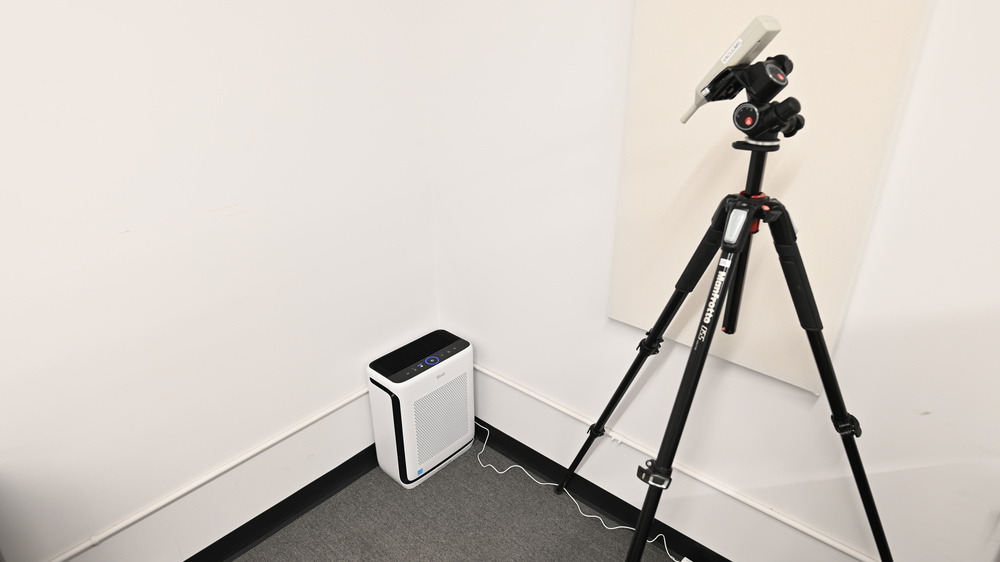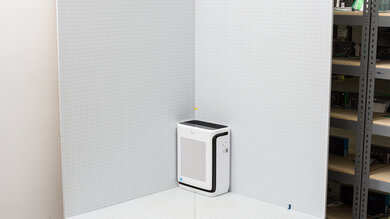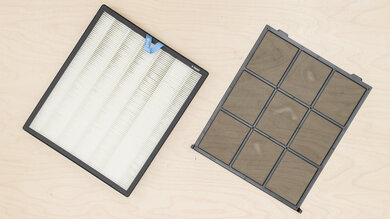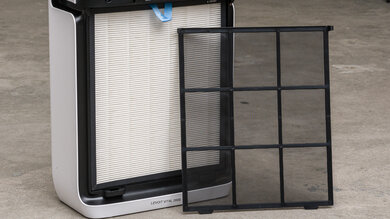The Levoit Vital 200S is an air purifier intended for medium-sized spaces. It's specifically marketed towards owners of heavy-shedding pets, with a U-shaped air inlet that's intended to resist clogs from large amounts of hair. Compared to models in Levoit's Core lineup, like the similarly sized Levoit Core 600S, which uses cylindrical filters, the Vital 200S uses rectangular ones. However, the underlying three-stage filtration system is very similar in design.
Our Verdict
The Levoit Vital 200S is an amazing option for pet owners. It does a fantastic job of capturing small particles like dog or cat dander, and its U-shaped air inlet is designed to purposely reduce the chances of hair from clogging the system. The manufacturer also offers a specially designed filter that's meant to provide additional protection against pet allergens and minimize pet odors. It even operates fairly quietly, which is good if your pet is sensitive to loud noises.
-
Built-in air quality sensor.
-
Great overall filtration performance.
-
Can be operated remotely using the VeSync companion app.
-
Bulky design isn't suited for tight spaces.
The Levoit Vital 200S is excellent for use in bedrooms. It might be a little on the bulkier side, but it does offer great overall filtration performance. It also runs quieter than most of its peers, even at higher fan speeds. You can also set schedules through the VeSync companion app to have it run at lower speeds at night. It also has a built-in light sensor that automatically turns off the display in dark rooms, so you won't have to turn off its display yourself.
-
Relatively quiet operation.
-
Built-in air quality sensor.
-
Great overall filtration performance.
-
Can be operated remotely using the VeSync companion app.
-
Bulky design isn't suited for tight spaces.
-
Built-in air quality sensor.
-
Great overall filtration performance.
-
Bulky design isn't suited for tight spaces.
-
Built-in air quality sensor.
-
Great overall filtration performance.
-
Bulky design isn't suited for tight spaces.
- 8.4 Pets
- 8.5 Bedroom
Performance Usages
- 8.3 Particle Filtration Rate
- 9.6 Particle Concentration
Changelog
- Updated Oct 31, 2024: Converted to Test Bench 1.0.1.
- Updated Jul 08, 2024: We've corrected an error in the 'Display And Control' section of the review where the air purifier was erroneously referred to by the wrong name.
- Updated Jun 25, 2024: Following user feedback, we've updated the text in the 'Filter Configuration' section of the review to remove any mention of HEPA filtration, as the manufacturer no longer advertises this device's main filter as being HEPA-rated.
- Updated May 14, 2024: We've made some slight in-text adjustments throughout the review that more accurately convey how this air purifier performs in relation to its peers.
- Updated May 13, 2024: Review published.
Check Price
Differences Between Sizes And Variants
The Levoit Vital 200S is available in three color variants: 'Black,' 'White/Black,' and 'White/Gray.' We tested the 'White/Black' model.
Let us know in the comments if you come across another variant of this air purifier.
Popular Air Purifiers Comparisons
The Levoit Vital 200S is a mid-range air purifier. While its bulky size can make it a hassle to squeeze into tight spaces, it has much to offer. It boasts impressive air purification performance and has a wide range of smart features that allow for practically hands-free operation. While it isn't quite as efficient at cleaning the air in larger rooms as the pricier Levoit Core 600S, it gets pretty close and has the added benefit of quieter operation.
If you're interested in alternatives, you can see our recommendations for the best air purifiers for bedrooms, the best air purifiers for pets, and the best air purifiers for allergies.
The Levoit Core 400S and Levoit Vital 200S are somewhat evenly matched machines, though we'd give the edge to the Vital 200S for most uses. Both machines deliver near-identical air purification performance and have similar smart features, but only the Vital 200S has a washable pre-filter and a U-shaped air inlet that's intended to resist clogs from pet hair.
The Winix 5500-2 and Levoit Vital 200S are evenly-matched air purifiers. Both appliances deliver near-equal particle filtration performance and a sufficiently high clean air delivery rate for larger spaces. That said, there are a few differences. Only the Levoit is Wi-Fi enabled, allowing you to pair the device with your smartphone, allowing for full remote operation and live monitoring of current air quality. Conversely, unlike the Levoit, the Winix has an ionizer, which produces negatively charged ions that ultimately cause small particles to be attracted to one another and form large, easily-cleaned clumps. That said, ionizers produce ozone, a potential respiratory irritant as a byproduct - while Winix claims their iteration of this technology doesn't produce harmful levels of ozone, you can always turn it off anyway.
Test Results
The ring of lights around the power button changes color based on current air quality:
- Blue: Very good
- Green: Good
- Yellow: Moderate
- Red: Bad
Tapping the 'Display Off' button turns off all of the device's indicator lights and the night light. On that subject, the night light features two levels of brightness. The 200S also has a light sensor, which automatically triggers the Display Off function if it detects that it's been put in a dark room. The device's lights will also automatically illuminate if you turn the lights on in a dark room. However, it's important to note that you have to enable this function through the VeSync smartphone app.
The VeSync companion app also allows you to remotely adjust the device's fan speed, set operating schedules, and send filter replacement reminders. You can also use it to view a real-time estimate of air quality.
This air purifier has a three-stage filter system comprising a pre-filter for trapping larger airborne particles and a combined primary and Activated Carbon filter for trapping mold and dust and minimizing odors. You'll only need to clean the pre-filter with a soft-bristle dusting brush or a vacuum every two to four weeks.
You'll need to replace the Primary/Activated Carbon filter every 12 months.
The manufacturer offers several replacement filters intended for more specific kinds of particles:
- Smoke Remover Carbon Filter: The manufacturer advertises this filter to reduce the amount of smoke particles in the air. You can buy this filter here.
- Toxin Absorber Carbon Filter: The manufacturer advertises this filter to trap dust and allergens. You can buy this filter here.
- 3-Stage Pet Allergy Carbon Filter: This filter is designed to better trap dander and cut down on pet odors. You can buy this filter here.
Comments
Levoit Vital 200S: Main Discussion
Let us know why you want us to review the product here, or encourage others to vote for this product.
- 21010
Hi CheneyQWER,
Thanks for reaching out with what you would like to see added! You’re right, the first iteration of our air purifier test bench is focused around CADR and final particle concentration. While this test coverage is a good start we are aware that there is a lot of expansion possible to make our reviews even more in depth. Since we want to improve them over time, I’ve taken note of your suggestions and we will definitely consider them once we start expanding our air purifier reviews. Thanks again for reaching out and do not hesitate if you have other suggestions you would like to see added.
- 32120
I think the biggest shortcoming of the current test methodology is that it does not include the cumulative clean mass (CCM) and the purifier’s performance for gases (such as formaldehyde and benzene).
A comprehensive performance test should include the following six parameters:
- CCM for particles
- CCM for gases (or formaldehyde)
- CADR for particles
- CADR for gases
- Final particle concentration
- Final gas concentration
Currently, your test only includes parameters 3) and 5). https://www.iqair.com/us/newsroom/measure-air-purifier-long-term-performance-ccm?srsltid=AfmBOopuRq_ZaR1GqePZhawIsZm4ntwtzYZgjmLw4e7LPrXYYFRZ5ykU
- 21010
Great write up! Could you consider adding PM 2.5 to your test results? I have a 3d printer and I’m trying to evaluate what air purifier does best at removing harmful PM 2.5 from my air. Not sure if you have a recommendation for this use case?
Hi austinyuan!
We currently test for particles 1.0 microns and smaller. PM2.5 takes into account larger particles than we test. If the air purifier is good for 1.0 microns, 0.5 microns and 0.3 microns, chances are that it would be good for bigger particles.
As for recommendations, here is a table that I made. It takes into account the Particle Filtration Rate, the Particle concentration (takes into account how low the air purifier is able to bring the particle concentration in the room in counts/Liters) and finally the dimensions of the air purifier to make sure that it can fit close to your 3D printer! I sorted the table by Particle Filtration Rate (best to worst) but feel free to play with the table to best suit your needs.
Thank you for your comment and interaction, these are always fun to read and reply. Have a good day
Pierre-André
- 21010
Great write up! Could you consider adding PM 2.5 to your test results? I have a 3d printer and I’m trying to evaluate what air purifier does best at removing harmful PM 2.5 from my air. Not sure if you have a recommendation for this use case?
- 43230
I wish you had an air filtration rate at certain DB available. I don’t personally care if an air purifier filters air faster if it’s 70db. you do mention the noise at different fan speeds but not the filtration rates
Hey ameliabuns!
You are bringing up a great way to improve our test bench! We might look to add this to our review in a future test bench update but we can’t make any guarantees at this time regarding a timeline for this.
Thanks for reaching out Pierre-André
- 43230
I wish you had an air filtration rate at certain DB available. I don’t personally care if an air purifier filters air faster if it’s 70db. you do mention the noise at different fan speeds but not the filtration rates
Update: Converted to Test Bench 1.0.1.












